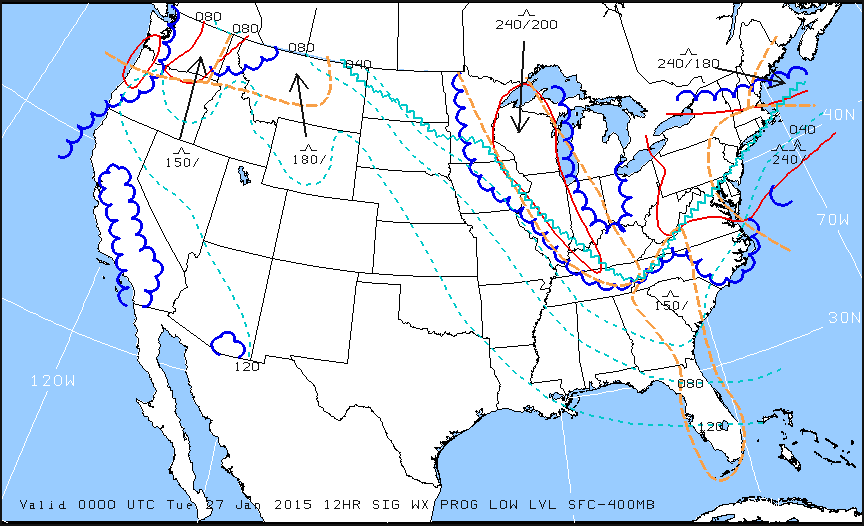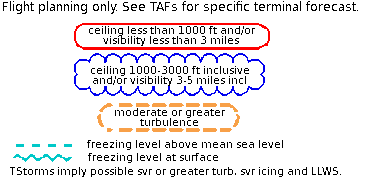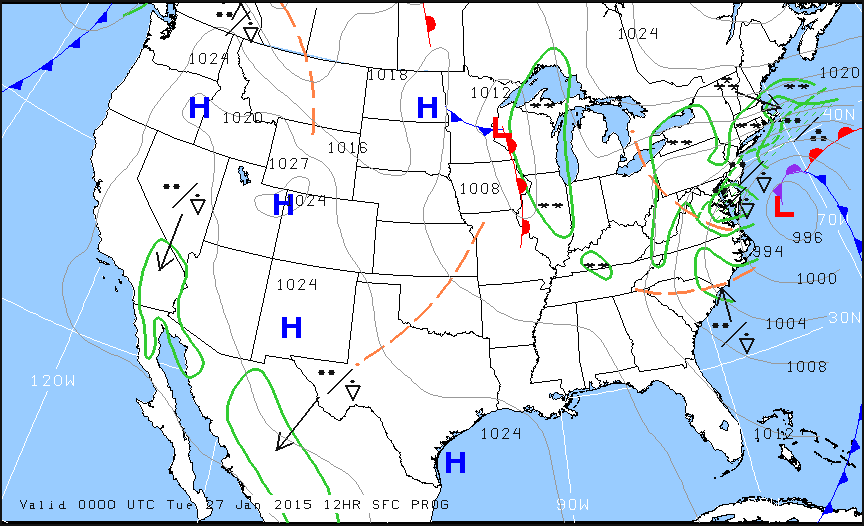There are a multitude of weather products out there today to assist pilots in preparing for a flight. Aviationweather.gov is the best source for getting all the information a pilot needs for planning a flight. Aviationweather.gov is the National Weather Service’s source for all aviation related weather products. When I teach about weather and weather briefings, I recommend to my students to utilize Aviationweather.gov in the planning stages, but still call the Flight Service Station to get a full fledged weather briefing before takeoff.
When preflight weather planning, one of the best ways to get a picture of what is happening over a broad area is utilizing the Low Level Significant Weather Prog charts. The Prog chart gives a forecasted 12 and 24 hour picture of what type of weather to expect over the US. The Prog chart gives the expected flight rules, areas of turbulence, and where the freezing level is located. If you’re looking at the 4 panel view, the Surface Prog chart shows fronts, pressure areas, and areas of expected precipitation. That covers just about everything, doesn’t it?
I believe the Prog charts are underutilized in planning. Foreflight and Garmin Pilot have given easy access to radar pictures, satellite pictures, METARs, TAFs, and several other sources of weather information. But, a lot of the easy access data you can get from those apps is current data (with the exception of the TAF) while a lot of the forecast data takes some hunting around. So, products like Prog charts aren’t often utilized.
The other problem arises when pilots know about Prog charts, but don’t know how to read them, then don’t know how to find the legend to decipher the chart, the chart is often set aside and quickly forgotten about just because of a lack of knowledge. Have no fear, though, as now we will use an example 4 panel Prog chart to decipher the lines and colorations.
Just looking at the Low Level Significant Weather Prog Chart above, it can be a little confusing. That’s why they make a legend!
Coupling the legend with the chart above, we can determine some things. First, California, parts of the Pacific Northwest, a small part of southern Arizona, and a good portion of the Midwest and East coast are going to have marginal VFR conditions in the next 12 hours. Wisconsin, Illinois, a good portion of the Northeast, and a small portion of the Pacific Northwest will suffer IFR from IFR conditions. There are going to be a good amount of low level turbulence in the northern and eastern parts of the country. Finally, the freezing level starts at the surface running in a jagged line across the midwest states and curling up into the Northeast.
That’s a good bit of information, isn’t it? If a pilot is planning a VFR flight into the Northeast tonight, it would probably be best to wait for another day, according to this chart.
Now, to see what is causing the conditions above, we need to look at the Surface Prog Chart.
The green circular areas above show that some form of precipitation is in that area. The circular dots with the triangle located in Mexico and Baja California are depicting moderate rain showers. If the triangle was gone, it would just be moderate rain. In the northeast, all those symbols are showing moderate to heavy snow showers. Across the plains, we see a lot of high pressure, meaning visibility and nice flying weather.
These charts are invaluable when it comes to flight planning, especially over long distances when the weather could be changing a lot over the period of your flight. Put them to use the next time you are planning a trip and you’ll learn you have a much better picture of what the weather is doing.




Thanks for the WX update on readingprog charts.
I think you left out an important part of the picture. Maybe it’s there, but I can’t find it. The question is WHEN?
The footnote tells when it was issued, but not WHEN it applies. Is it a statement of present conditions? Or is it a forecast of conditions at some future time? Somewhere that information is available, but I can’t find it.
Albert Holt
AL@holtmarinesystems.com
Hi Albert, at the bottom of the Prog Chart itself, there is an issue time, then directly below it, there is a valid time. That valid time is when it applies. Surface Analysis charts are current, but Prog charts are always forecast. Unless of course, they haven’t been updated, then it’s showing what was supposed to take place in the past.